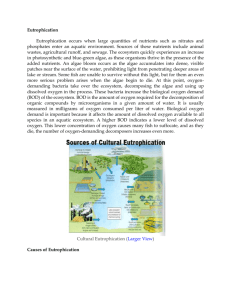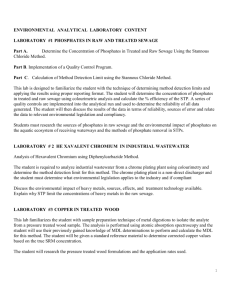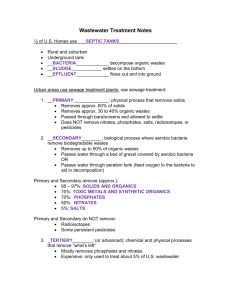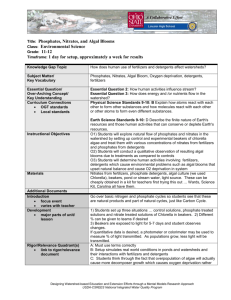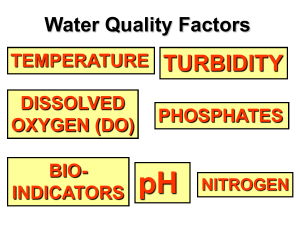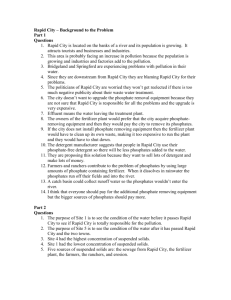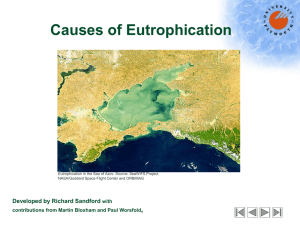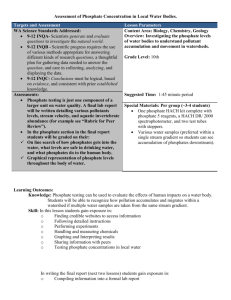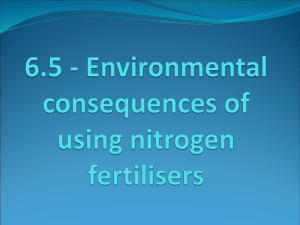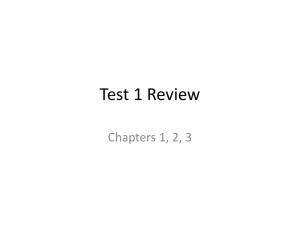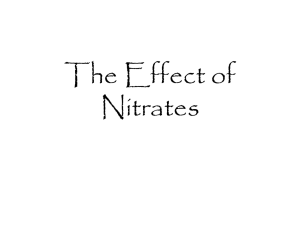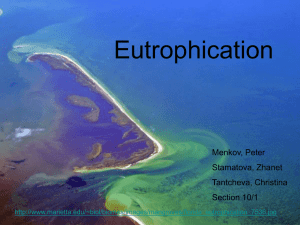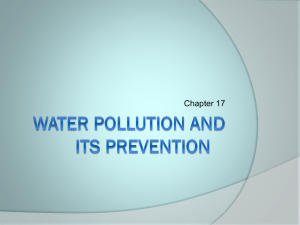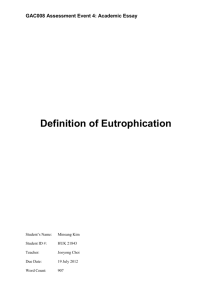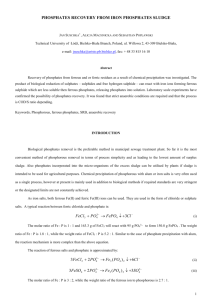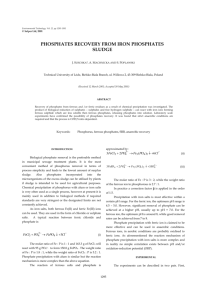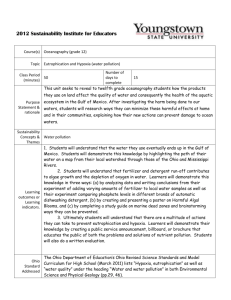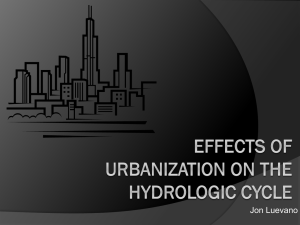22. Eutrophication
advertisement
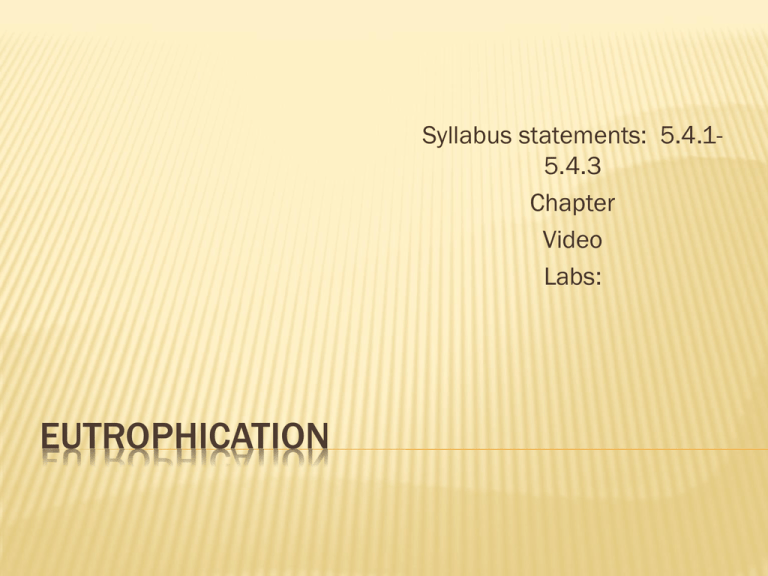
Syllabus statements: 5.4.15.4.3 Chapter Video Labs: EUTROPHICATION SYLLABUS STATEMENTS 5.4.1: Outline the process of eutrophication 5.4.2: Evaluate the main impacts of eutrophication 5.4.3: describe and evaluate pollution management strategies with respect to eutrophication VOCABULARY Biological oxygen demand Eutrophication Positive feedback EUTROPHICATION IS The natural or artificial enhancement of a body of water, particularly with respect to nitrates and phosphates, that results in depletion of the oxygen content of the water It is accelerated by human activities that add detergents, sewage or agricultural fertilizers to bodies of water Satellite imagery of the Caspian Sea showing increased turbidity (cloudiness) in the north and east eutrophication PROCESS OVERVIEW 1. 2. 3. 4. 5. Increase in nitrates and phosphates Rapid growth of algae Accumulation of dead organic material High rate of decomposition Decrease in oxygen ENHANCING NATURAL EFFECT In natural conditions plant communities uptake nutrients and clays in soils trap them Human alterations remove this storage and increase inputs as well Sewage effluent – nutrients from waste plus detergents (phosphates) Agriculture – animal waste & inorganic fertilizer runoff FEEDBACK MECHANISM Positive feedback involved More nutrients mean more plants More dead plants means more organics means more nutrients More plants… Until death and decomposition outweighs everything else… EUTROPHICATION IMPACTS Death of Aerobic organisms Increased turbidity Loss of macrophytes Reduction in the length of food chains Loss of biodiversity DEAD ZONE FORMATION Worldwide problem in coastal waters (146 areas) In Gulf of Mexico – mouth of Mississippi – area the size of Massachusetts gets so O depleted (hypoxic) that every aerobic organism that can’t flee dies Varies in size but growing Nearshore waters are important fisheries (Gulf one is 18% of US catch) and nursery grounds They are in jeopardy RECALL POLLUTION MANAGEMENT Human pollutants produce long term and far reaching effects Strategies for reducing impacts can be directed at three different levels in the process 1. 2. 3. Altering the human activity Reducing the quantity of pollutant released at the point of emission Cleaning up the pollutant and restoring the ecosystem after pollution occurs ALTERING THE ACTIVITY THAT POLLUTES Phosphate free detergents in the home Reduced residential use of lawn fertilizers Move agriculture away from inorganic broad scale fertilizers to specifically applied organic fertilizers and manures Soil conservation REGULATING AND REDUCING EMISSIONS Sewage treatment modifications Traditionally remove solids and purify but leave nutrients in effluent Advanced (more $$$) but removes nutrients for agricultural application Treatment marshes on farms Use natural wetland capabilities for farm waste treatment Secondary Primary Bar screen Grit chamber Settling tank Aeration tank Settling tank Chlorine disinfection tank To river, lake, or ocean Raw sewage from sewers Sludge (kills bacteria) Activated sludge Air pump Sludge digester Sludge drying bed Disposed of in landfill or ocean or applied to cropland, pasture, or rangeland Effluent from secondary treatment Alum flocculation plus sediments Activated carbon Desalination (electrodialysis or reverse osmosis) 98% of suspended solids 90% of phosphates Nitrate removal Specialized compound removal (DDT, etc.) To rivers, lakes, streams, oceans, reservoirs, or industries 98% of dissolved organics Recycled to land for irrigation and fertilization Most of dissolved salts CLEAN UP AND RESTORATION Mud can be pumped out of eutrophic lakes Plants can be reintroduced to restart natural nutrient cycling Once that takes hold reintroduce fish REMEMBER THERE ARE MANY FACTORS TO STOP Discharge of untreated municipal sewage (nitrates and phosphates) Nitrogen compounds produced by cars and factories Natural runoff (nitrates and phosphates Inorganic fertilizer runoff (nitrates and phosphates) Discharge of detergents ( phosphates) Discharge of treated municipal sewage (primary and secondary treatment: nitrates and phosphates) Lake ecosystem nutrient overload and breakdown of chemical cycling Dissolving of nitrogen oxides (from internal combustion engines and furnaces) Manure runoff from feedlots (nitrates, phosphates, ammonia) Runoff from streets, lawns, and construction lots (nitrates and phosphates) Runoff and erosion (from cultivation, mining, construction, and poor land use)
